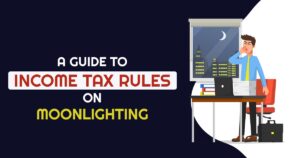 Moonlighting presents opportunities and challenges, particularly in terms of taxation and regulatory compliance
Moonlighting presents opportunities and challenges, particularly in terms of taxation and regulatory compliance
Income Tax Return Filing AY 2024-25: Moonlighting, the practice of taking on additional employment besides one’s primary job, raises concerns when done without the primary employer’s knowledge. Often undertaken to supplement income or explore personal interests, it requires careful consideration of potential conflicts, time management, and legal implications, especially concerning one’s principal employment. Moonlighting presents opportunities and challenges, particularly in terms of taxation and regulatory compliance.
Suresh Surana, a practicing chartered accountant, provides an overview of the tax implications of moonlighting for taxpayers.
1.0 Taxation of Income from Moonlighting
For employees earning moonlighting income, the income tax treatment depends on the nature of the income:
1.1 Income from Salary
When moonlighting income is received under an employer-employee relationship as salary, bonus, commission, remuneration, or perquisites, it is taxed under the head ‘Income from Salaries’ at applicable slab rates.
For tax return filing, individuals who have moonlighted during the financial year must obtain Form 16 from all employers and consolidate the gross salary earned from all sources. The total amount of tax deductions/exemptions a taxpayer can claim, such as house rent allowance, leave travel concession, and the standard deduction of Rs 50,000 Under Section 16(ia) of the Income Tax Act (IT Act), 1961, is computed on the total gross salary if the old tax regime is opted for.
Further, tax deductions or exemptions allowed u/s 80C, 80D, interest earned on bank accounts, mutual funds, etc., are computed on consolidated income depending on the chosen taxation regime.
1.2 Professional Income
Taxpayers earning moonlighting income from a profession carried on in addition to their primary job are taxed under the head ‘Profits and Gains from Business or Profession’ at applicable slab rates. Taxpayers can claim deductions for profession-related expenses while computing their income under this head.
Option for Presumptive Taxation
Professionals with a total turnover of up to Rs 50 lakh (enhanced to Rs 75 lakh if cash receipts during the financial year 2023-24 do not exceed 5 per cent of the total gross receipts) can opt for presumptive taxation u/s 44ADA of the IT Act. Under this scheme, a resident taxpayer engaged in specified professions such as legal, medical, accountancy, or engineering can compute profits or gains from the profession at 50 per cent of the total gross receipts.
Features of the Presumptive Taxation Scheme:
3.0 Applicable Income Tax Returns
Taxpayers must select the appropriate Income Tax return form based on their income sources and levels. Here’s a brief overview:
ITR 1 (Sahaj): For resident taxpayers with total income up to Rs 50 lakh, having Income from Salaries, one house property, other sources (Interest, etc.), and agricultural income up to Rs. 5000.
ITR 2: For taxpayers not having income from profits and gains of business or profession and/or not eligible to furnish ITR 1.
ITR 3: For taxpayers having income from profits and gains of business or profession.
ITR 4 (Sugam): For resident taxpayers opting for Presumptive Taxation.
4.0 Other Return Filing Considerations
When filing Income Tax Returns (ITR) in India with moonlighting income, taxpayers should ensure compliance with tax laws by:
Maintaining Detailed Records: Keep accurate records of moonlighting income, including invoices, receipts, and bank statements.
Claiming Deductions: Utilise available deductions such as Section 80C (for specified investments) and 80D (for health insurance premiums) to lower taxable income. Ensure proper documentation to support deductions.
Accounting for TDS: Claim credit for TDS if deducted from moonlighting income when filing ITR. Verify TDS details in Form 26AS/ Annual Information Summary (AIS)/ Tax Information Summary (TIS).
In a Nutshell
While moonlighting offers flexibility and financial benefits, it requires careful tax planning and adherence to regulatory requirements. By following the above guidelines, individuals can ensure proper reporting of income, assets, and payment of taxes under income-tax regulations.
Source: https://www.news18.com/business/itr-filing-for-moonlighting-know-tax-implications-of-holding-two-jobs-simultaneously-in-ay2024-25-8947386.html
© 2018 CA Chandan Agarwal. All rights reserved.